ETHNOLOGY, LANGUAGE, AND RELIGION OF CEYLON-1893
Posted on December 10th, 2016
Prepared by Rohan Ekanayake
Extracts from 1893 book Titled as CATALOGUE OF EXHIBITS in the Ceylon Courts at the WORLD’S COLUMBIAN EXPOSITION AT CHICAGO -1893”. H.C COTTLE -GOVERNMENT PRINTER, CEYLON.1893. (Page 16-22, 78, 79, 66-68, 76 and 77) ·
Search the book https://www.scribd.com/document/333722531/Official-Handbook-and-Catalogue-of-the-Ceylon-Court-1893· Download the book (12.54mb) – https://www.mediafire.com/?hm8o8xo38ds92ix
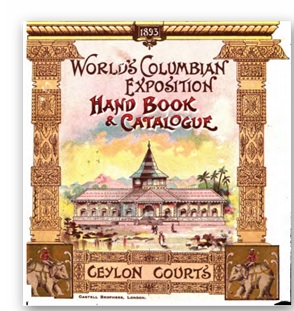 |
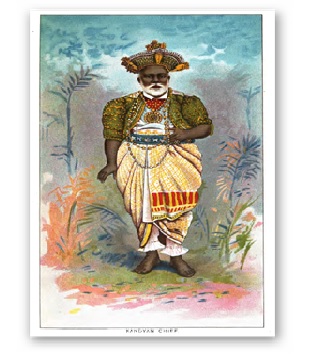 |
Names of the Island.—The name Ceylon” represents the native word Siiha1a” (pronounced Singhala), of which the historical origin is uncertain, though Siha” means lion.” A shorter and more strictly local form of the same word is Elu”; and with the addition of dipa”, island,” it forms Selpan-dib” or Serendib.
In the classical language of India. and in ordinary native use in Ceylon itself, the Island is called Lanká.” A third name, perhaps the oldest geographical name of the Island, was Tàmraparni”, which in Greek and Latin became Taprobane”, and is used by Milton.
CEYLON (part, as many believe, of the region known to the Hebrews as Ophir and Tarshish), Taprobane of the Greeks and Romans (from Támrapazie, Sanskrit, and Tambapáni,Páli); Serendib of the Arab voyagers; Laká of the Continental Hindus and the Sinhalese; Ilangei of the Tamils; Lankápura of the Malays; Tewalanká of the Siamese; Seho or Teho of the Burmese; Ceilaõ of the Portuguese, &c.;Pearliform Island ( Pearl-drop on the brow of ind ). (page 68)
Elernent of the Population.—The large majority consists of the Sihalese, the nation who have held Ceylon through out historic times (probably from the fifth or even sixth century B.C.), but the northern part is occupied by Tamils, a distinct race (Dravidian), who have immigrated in past centuries from South India. These settled Tamils are also numerous in most of the large towns. From the same race are constantly drawn the labourers (coolies, over 200,000 in number), by whose toil is produced the tea for which the Island is so justly famous.
Moormen.—A third and very energetic element of the population is formed by the Moormen” (that is, Moham medans), a race of Arab origin who, in Ceylon as in South India, do a large part of the local trade, and who live distinct from the other races, with recognized institutions and even laws of their own.
Burghers.—The descendants of the Portugese, who occupied parts of the Island from near 1500 to about 1650 A.D., and of the Dutch who succeeded them, and handed it over to the English a little before 1800, are alike called Burghers”, though the title must have belonged originally to the Dutch. Few of these Burghers are now of unmixed European descent, but most are Qf unblemished, and some of noble origins. The term Eurasian is not applied to them.
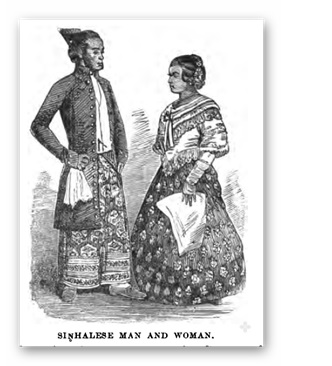 |
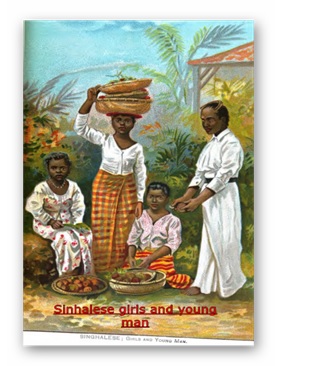 |
The number of each race given in the Census of 1891 is as follows:—
· Europeans … … 4,678·
Sihalese … … 2,041,158·
Burghers … 21,231·
Tamils … 723,853·
Moormen … 197,166·
Malays … … 10,133·
Vçddahs … … 1,229
Origin of the Sinha1ese.—Of the Tamils, Moormen, and other races not peculiar to Ceylon, this is not the place for any account. The elements of population peculiar to Ceylon are the Sinhalese and the Veddahs.
According to tradition, both Indian and local, the Sinhalese are of Aryan race and connected with the north of India; and this is borne out by language, customs, and subsequent history. The ancient North Indian poem Ramayana (dating from 500 B.C. at least), and the inscriptions of Asoka (250 BC.),prove early intercourse between North India and the Island; and the chronicles, compiled in Páli in the fourth and fifth centuries A.D. out of the archives of the great Buddhist monastery at Anurádhapura—(it is the peculiar distinction of the Sinhalese among Indian peoples to possess such histories)—describe the establishment of the Buddhist religion in the Island by Aryan influences in the third century B.C. These same chronicles ascribe, and with all probability, the previous civilization of the Island to Aryan immigration.
Siihalese Language.—The Sinhalese language is closely akin to the Sanskrit; that is, it is one of that group of Indo-Aryan languages of which Sanskrit is the literary type. It comes nearer probably to the Bengali than to any other of the present forms of this group.In its modern form, its true characteristics are disguised by the abundance of words which it has borrowed in later times from the Sanskrit, just as the old English stock of times from the Sanskrit, just as the old English stock of words akin to Latin but not borrowed from it is overlaid by a later borrowing. For instance, man,” name,” and draw” correspond to the older and truer Sinhalese;human,” nomenclature,” attract,” to the modern element in it. But the Sinhalese is much nearer to the Sanskrit than the old elements of English are to the Latin.
This old Sinhalese, or Elu, is characterized, in comparison with Sanskrit, by lightness and brevity, avoiding long vowels, compound consonants, and long words. Rakshá” is in Siha1ese ráká,” manushya” is miniha,” kshíra,” is kin,” &c. The pronouns as ma,” me”; the numbers, all radically identical with our own; the verbal terminations mi,” si,” ti”; and not a few common words which, in the course of change, have rested in a form like the English—such as dora, door,” band, bind,” &c.—show us that the Sinhalese language belongs to our own Aryan stock.
Relation to Páli.—It is probably a mistake to call Sinhalese a derivative of Páli, though this, being the sacred language of Buddhism, has greatly influenced Sinhalese .Like Páli, Sinhalese avoids all compounds of r, but unlike Páli it rejects double letters, and allows short diphthongs. Hence the usual sequence of the three languages is represented by the series, márga, magga, maga; or sreshta, settha,seta.
Relation to Tamil.—During nearly the whole of its history Ceylon has been in close relations, sometimes hostile through invasions and occupations, sometimes friendly through alliance and settlements, with the Dravidian races of South India, especially the Tamil; and the Sinhalese language has been greatly affected, especially in the later three or four centuries, by the influence of Tamil, from which it has borrowed not only words, but grammatical forms and inflections of verbs and nouns. The most usual form of plural, in the modern Sinhalese, is probably an imitation of the Tamil plural. But there is no fundamental Dravidian element in the language.
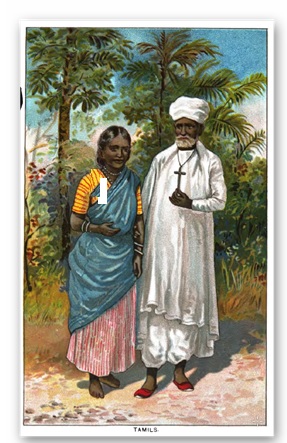 |
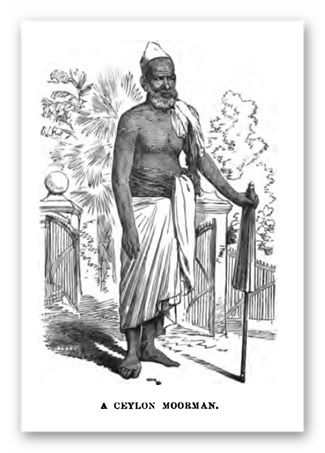 |
Relation to European Languages.—Many Portuguese words, names of things which the Portuguese introduced, have become naturalized in Siha1ese; and not only the words fer table” (mésé), bread” (pán), and carriage” (karatté),but that of the now characteristic hackery,” are of this origin. The Dutch language, coming afterwards, left far less trace, though a verandah” (itself a word which the English climate obliged us to borrow from the East) is still called an istoppuwa” (stoep” at the Cape). The present prevalence of English in the maritime provinces is producing rather a jumble of both languages than a legitimate modification of the vernacular. A corrupt Portuguese is still poken by a decreasing number of the Burgher community.
Veddahs.—A small element of the population, but one of considerable ethnological interest, is formed by the Veddahs (or hunters ), whom some suppose to represent the aboriginal pre-Aryan population of Ceylon, corresponding to some of the mountain tribes of India. It may be doubted whether a distinction of race has been established, and certainly the peculiarities of the Veddahs have been exaggerated e.g., that they cannot laugh:! Many of them have been induced without much difficulty to adopt a civilized life, and are called Village Veddahs ; these speak Siha1ese or Tamil, according to their neighborhood; they fish, hunt, or even farm; and a few of them are genuine Christians. But it is commonly believed that there are still left, about the east center of the Island, some of the genuine Rock Veddahs,” who live by the bow and the snare; store their meat, pickled in honey, in hollow trees; and avoid intercourse with other men; and who, formerly at least, used to bargain with their Siha1ese neighbours by leaving at the edge of the forest a model of the tool or article which they wanted to buy, and the haunch of venison with which they proposed to pay for it, coming afterwards in silence and secrecy to carry off their purchase. The Veddahs are enumerated in the late Census at 1,229, but it is thought that many put themselves down as Sinhalese or Tamil.
Religion.—In respect of religion the population of Ceylon is thus divided :—
Christians … … 302,127
Hindus … … 615,932
Buddhists … … 1,877,043
Mohainmedans … … 211,995
Of the Christians the majority are the descendants of those who were Christianized by the Portuguese, a smaller number of those who were Christianized by the Dutch, and the remainder are the converts of the missions of this century.In the decade 1881—91 the increase in the number of Christians was 13 per cent., while that of the general population was 9 per cent. Of the 302,127 Christians, 246,214 were returned as Roman Catholics, and this is perhaps rather below the number. The Hindus belong chiefly to the Sivite, and the Moham medans to the Sunni sect.
The form of religion, however, which is most characteristic of Ceylon is Buddhism, which has a longer continuous history here than anywhere else. It is Buddhism of the Southern” school; and its teaching claims to be a faithful representation of that which was originally propounded in the valley of the Ganges in the sixth century B.C., and which is formulated in the three-fold collection of På.li treatises called the Tipitaka.” This is rather a system of human conduct than a religion, since it has no place for worship, prayer, or approach to a person. Its teaching knows nothing of Creator, Saviour, or Judge; and rests on the assumption that while there is no radical distinction between the different grades of living beings (the demons and the brutes who are below man, men, and the super natural beings above men), all these are alike miserably involved in an endless and wearying series of successive births and deaths; but that among all these the most favorable position is occupied by the Buddhist monk, and above all by the Buddha himself. The Buddha is the title of the teacher, Gautama by name, who first in this cycle of the world discovered the true nature of existence, and has taught it for the benefit of all classes of living beings. The secret discovered and taught is briefly this: that evil is inseparable from existence, and that there is therefore no other way of escaping evil but to escape existence. To this purpose the disciple is taught to destroy in himself all which tends to attach him to anything, to maintain him in any relations with the external world, or to foster in him any desire for it; and so to withdraw himself from existence. This withdrawal, like the going out of a flame for want of fuel, is called Nirvána, and is virtually attained as soon as there is no longer any danger of any other life succeeding this one. It is finally entered on when the last life comes to an end.
This dreary theory wears however a very different aspect when it comes to be worked out in detail. The chief obstacles to escape from existence are held to be lust, anger, pride, and error; and the circumstances favorable to such escape to be purity, kindness, meekness, and insight. In the insistence on those moral principles the Buddhist teaching, as found in the Tipitaka” and the commentaries thereon, attains a high level of excellence; and an immense collection of illustrations, fables, and legends sets its moral injunctions in a strong light. The system is marred by the want of any recognition of the right use of the emotions, or of any reference to beings morally superior to man; and by the insistence, to an extravagant degree, on the supposed importance of avoiding the taking of animal—or even vegetable— life.
In modern Ceylon the theory as above sketched is in the background, and is practically superseded by a simple but defective system—in which the law against taking life occupies a grotesquely disproportionate place—for obtaining after death, through acts of merit done here, birth in one of the many heavens or places of enjoyment. This is mixed, in the popular mind, with a complicated superstition—partly Hindu and partly of lower origin—by which every event of life and every natural circumstance is connected with gods, demons, planets, charms, and rites of exorcism.
Externally, the Buddhism of Ceylon is seen in graceful processions, simple offerings of flowers, and in the maintenance, by the daily alms of the common people or the liberality of the rich, of a large number (nearly 10,000) of priests,” or more correctly monks,” whose dignified figures with their shaven heads and toga-like yellow robes are one of the characteristic elements in the picturesque scenes of the Island.
Population — Results of Census of 1891; 1 per cent can be added for each year since. 3,007,789 (over 3,073,000 probably in 1893); 119 to square mile, ranging from 19 in North-Central Province to 53’2 in Western. Races (estimated): Sihalese (Kandyan and maritime) 2,041,158; Tamils 723,853; Moormen 197,166;Malays 10,133; Javanese, Kafirs or Negroes, Afghans, Arabe,Persians, Parsees, &c., 8,341; Veddahs 1,229; European descendants 21,231; Europeans 4,6Th.
About 235,000 of the Tamils are immigrants, balance of nearly 3 million who came from Southern India (chiefly to labour temporarily on coffee estates) in 52 years ending 1892,and who have settled down here, besides which there is a floating ‘Tamil population of nearly 200,000 more. Nearly one-fourth of the Europeans are military and families.Effective military number about 1,250. Native soldiery (since the disbandment of the Ceylon Rifle Regiment)consists of 214 Asiatic Artillery and Gun Lascars. Total military (Volunteers, European, and native), with women and children, say 4,000. Constituents of European popula tion, the wives and families included:—Military 1,670;planters 4,000; the Colonial Service (Civil Servants proper number 80, with 15 Writers) 900; merchants and their employés, clergymen, physicians, storekeepers, railway, &c.,1,600. There are of all classes about 725 lawyers, advocates, and proctors in Ceylon, with 737 notaries; 1,048 clergymen and missionaries (178 Europeans); 2,280 physicians, medical practitioners, and surgeons (besides 4,333 native vedaralas); 200 justices of the peace and unofficial police magistrates.(page 77,78)